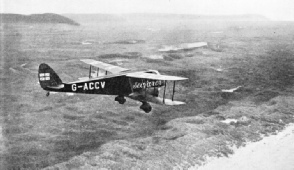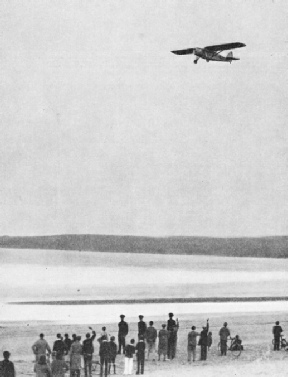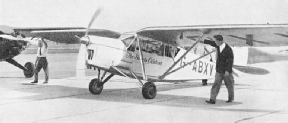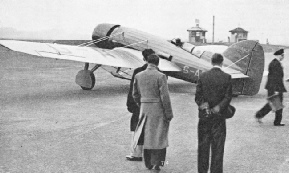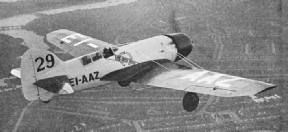

© Wonders of World Aviation 2015-
James Allan Mollison
Many Records Were Broken by Mollison During his Long-Distance Flights Over Land and Sea
MAKERS OF AIR HISTORY - 12
A RECORD CROSSING OF THE NORTH ATLANTIC from east to west was made in 1933 by Mollison, accompanied by his wife, in the Seafarer. They were attempting to make a non-stop flight from Great Britain to New York, but shortage of petrol forced them down when they were only about twenty minutes' flight from New York. The Seafarer was a De Havilland Dragon aircraft in which the passenger seats had been replaced by extra petrol tanks.
WHEN he obtained a short service commission in the Royal Air Force, James Allan Mollison, aged eighteen years, was the youngest officer in the Service. That he should have begun his flying career with a record was characteristic of the man who was to create so many records in aviation. During his career in the Royal Air Force Mollison served in India, where he was awarded an India General Service Medal for active service in the Waziristan Campaign in 1925.
When he had served the period of his short service commission, Mollison went to Australia, not as an aviator, but as a bathing beach attendant. That he would have returned to aviation sooner or later was inevitable, but his decision to do so was hastened while he worked as a beach attendant.
One afternoon an aeroplane from the New South Wales Flying Club flew low over the water. Mollison had not flown since his R.A.F. days, but the sight of that aeroplane and the noise of its engines reminded him that flying was the one thing in life he wanted to do. He gave out his last towel, organized his last bathing party and obtained a post as instructor to the South Australian Flying Club, at Adelaide.
He was particularly well qualified for such a post. Towards the end of his Service career he had been an instructor at the R.A.F. aerodrome at Sealand, near Chester, where, at the age of twenty-two, he had been the youngest instructor in the Royal Air Force. In fourteen months he had taught fifteen officers to fly.
He had been teaching at the South Australian Flying Club for only a week when the authorities ordered him to stop flying because he lacked a “B” licence, without which no one may be a professional flying instructor. With the audacity that was to see him through many a crisis in his life, Mollison went to Melbourne, where he persuaded the authorities that he was a good enough pilot to be awarded his “B” licence without having to pass the necessary examination.
He was an instructor for a year until he became an air-line pilot on the Sydney-Melbourne route as co-pilot with the late Sir Charles Kingsford Smith. Mollison flew over the Melbourne-Sydney route in the pioneer days of mailplane work. On every trip he had to contend with the worst possible weather conditions in machines that were not equipped with blind flying instruments. These daily contacts with arduous and dangerous conditions were a perfect apprenticeship for the great flights he was to make.
He decided to make the first of these great flights when he met C. W. A. Scott, whom he had known in his R.A.F. days. Scott was at Brisbane preparing to attempt a record flight to England. The sight and sound of an aeroplane flying low over a Sydney beach had drawn Mollison back to aviation; and listening to Scott’s plans made him decide to try spectacular flying. There were no half measures about Mollison. His decision to take part in the more spectacular side of aviation did not remain with him as some idle daydream. Having made up his mind to try to beat his friend Scott, he soon discovered that Lord Wakefield of Hythe had backed some of the big flights. He met Lord Wakefield’s Australian manager and told him of his ambition to fly from Australia to England. A cable was sent to England. If it occurred to Mollison that there were several reasons why his lordship should refuse to back an unknown aviator they did not deter him from making his request; neither was he deterred by the fact that Lord Wakefield was on the other side of the world, some 10,000 miles away.
Mollison’s optimism was justified, for Lord Wakefield agreed to back him, and a Moth was specially built.
Mollison left for Port Darwin, the taking-off place for the flight, long before the patient and perhaps more methodical Scott was ready. Now that he was a day ahead of Scott, Mollison wasted no time. He landed at Port Darwin in the evening. Shortly after midnight he took off. But the Moth was heavily overloaded with fuel for a range of 2,000 miles. The machine was barely able to leave the ground, and did not, in fact, fly higher than a line of telegraph posts and wires just beyond the boundary of the runway. With such a load it was impossible for Mollison to avoid these wires. He crashed into them, and his first attempt at a record-
breaking flight ended in disaster and might have ended fatally. The machine was a total wreck, but Mollison was unhurt.
Undaunted, Mollison cabled to Lord Wakefield and asked for another chance. It was like a gambler’s last desperate throw, but once again it came off. Lord Wakefield agreed to sponsor a second attempt. Meanwhile, Scott got away and went on to make a record crossing to England. Mollison was undiscouraged, and his new Gipsy Moth was ready for him some six weeks after his first disastrous attempt.
At 1 a.m. (local time) on July 29, 1931, Mollison took off on his second and last chance to make good. He had gambled every-thing on this flight. He left Australia, without a job, with the knowledge that failure would mean that he would never have another backer, and with £5 as the only money he had in the world.
If it is true that fortune favours the brave it certainly favoured Mollison, for he covered the 10,000 miles to England in eight days nineteen hours twenty-five minutes, and beat Scott’s time by more than two days. It was an outstanding triumph for pilot and machine, but particularly for the pilot, who had been a novice at long-distance flying of that nature. Gone were obscurity and the possibility of lack of backers. Mollison had not found fame in a night, but he had found it in a little less than nine days.
THE GREATEST SOLO FLIGHT ever made was probably that by Mollison when he crossed the North Atlantic in 1932 from east to west in a light aeroplane. Lindbergh’s solo flight in 1927 was from west to east, so that he had the prevailing winds in his favour. To get a long enough run for his heavily loaded machine, The Heart's Content, Mollison took off from Portmarnock Strand, Dublin. This photograph shows his machine at the beginning of the great flight.
There was nothing prophetic about that. His great flight was no nine days’ wonder, but a prelude to even more records. In November of that same year he planned a solo flight to the Cape in a Puss Moth aeroplane. Once more his first attempt was a failure, although he flew to Egypt in thirty-seven hours before his machine crashed at night and landed upside down in a maize field. He waited until March of the next year, 1932, before he tried the Cape flight again. He chose the West Coast route in preference to the “all red” route used by Imperial Airways. The length of the West Coast route was about 6,000 miles; the “all red” route was some 800 miles longer. Because of the shorter distance Mollison chose the West Coast; the alternative route had everything else in its favour except that of distance. To use the West Coast route - or before he reaches the Coast - a pilot must cross a 2,000-miles’ stretch of the Sahara and hundreds of miles of jungles and uninhabited and unexplored country, where forced landings mean certain death. On the other hand, machines using the “all red” route follow populated areas, find navigating less difficult, have numerous aerodromes, and a reasonable chance of help in the event of a forced landing.
Mollison took off from Lympne, in Kent, and flew to Colomb Bechar, which he reached that same evening. The next day he set off for Reggan, a French outpost on the fringe of the Sahara. From here he crossed that hazardous 2,000-miles’ stretch of desert, flew over the Niger River and landed at Niamey. From Niamey he flew to Duala, and from there he went down the West Coast to Loanda, Walvis Bay, Cape Columbine and then on to the Cape, which he reached after a flight of 6,000 miles in the remarkable and record time of four days seventeen hours nineteen minutes.
After this flight his reputation as a pilot and navigator was high, but he now planned another flight, which was to set the seal on that reputation. It was a flight which will probably go down to history as the greatest solo flight ever made. He planned to cross the Atlantic from east to west, that is, from the British Isles to America. There had been successful solo flights over the North Atlantic. Charles A. Lindbergh had flown from New York to Paris in May 1927. But Lindbergh’s flight, magnificent though it was, was made from west to east, which, because of the prevailing winds, is the easier course. There had been no successful attempt at a solo flight from east to west, although Kohl, von Hunefeld and Fitzmaurice had succeeded in April 1928, Kingsford Smith and three companions in June 1930, and Costes and Bellonte in September 1930.
Caught in Newfoundland Fogbank
The De Havilland Company built Mollison a Puss Moth with a 120 horsepower Gipsy III engine, and having a cruising speed of 110 miles an hour. Mollison called this machine The Heart's Content. The Puss Moth was a remarkable example of British aviation design and manufacture. Its construction created new problems for designers. It was only a light aeroplane, but it had to have a range of 2,000 miles against headwinds that might be as strong as 40 miles an hour. The normal fuel load of The Heart’s Content was 20 gallons, but Mollison loaded it up with 160 gallons, or enough for a range of 3,600 miles or thirty-three hours’ flying. It was believed (and hoped) that such a fuel-load would be enough not only for the crossing, but also to allow for any drifting off the course.
An aeroplane with so heavy a load needs a long runway for the take-off. As there was no aerodrome in England with such a run-way, Mollison decided to take off from Portmarnock Strand, Dublin. He arrived there in August 1932 and waited for favourable weather. It proved to be a long wait. He reached Portmarnock Strand at the beginning of August, but he had to endure the strain of waiting until the eighteenth of the month before he could leave. He had arranged to make his attempt while there was a full moon for his night flight over the North Atlantic. Each day that passed meant that the best phases of the moon would soon pass also.
Mollison, however, had learnt at Port Darwin that more haste meant less speed. He waited at Portmarnock Strand until 11.35 in the morning of August 18. Thirty-one hours twenty minutes later he had arrived at Pennfield Ridge, about fifty-five miles from St. John, New Brunswick. He had achieved the biggest triumph of his career, and one of the biggest triumphs in the history of aviation. But it had been a near thing. When he landed at Pennfield Ridge he had only about ten gallons of fuel left in the tanks, enough for but two hours’ flying. If he had had more fuel he would have carried out his original intention of flying non-stop from Dublin to New York by way of Newfoundland.
ONLY TEN GALLONS OF FUEL WERE LEFT in the tanks of The Heart’s Content when Mollison landed in New Brunswick after his solo crossing of the Atlantic. This was enough for but two hours of flight. The aeroplane was a specially built De Havilland Puss Moth with a 120 horse-power Gipsy III engine, giving it a cruising speed of 110 miles an hour. Mollison loaded it with 160 gallons of petrol, enough for a range of 3,600 miles or thirty-three hours’ flying.
Despite the headwinds and bad weather, he had crossed the North Atlantic itself in twenty-four hours, but for seven hours he had been caught in the notorious Newfoundland fogbank which every aviator and sailor dreads; during those seven hours Mollison had searched for a possible landing place, not daring to risk a landing without seeing the ground because of the peaks which fringed the coastline and which were hidden by the fog.
The idea of a direct non-stop flight to New York still attracted him, but before he attempted it again, he made in 1933 a remark-able flight across the South Atlantic to South America, being the first man to fly from England to South America and the first aviator to fly westward across the South Atlantic alone. He flew in The Heart’s Content.
It was in July 1933 that he considered a flight from the British Isles to the United States of America. He planned such a flight with Miss Amy Johnson, who was then Mrs. Mollison. A Dragon twin-engined air liner was built for them by the De Havilland company. It was a ten-seater aeroplane, but the passenger seats were removed so that large cylindrical petrol tanks could be fitted. These tanks were loaded with 600 gallons, which gave them a range of 7,000 miles. This enormous fuel range is explained by the fact that one of the Mollisons’ ambitions was to fly from New York to Baghdad non-stop, either immediately after the North Atlantic crossing or at some date in the near future. But their immediate object was the first direct non-stop flight from London to New York.
Once again Mollison was threatened with disaster at the beginning of a great flight. The Seafarer, as they had named the Dragon, began to take off from Croydon Airport, but it travelled only some 200 yards, without rising, when the undercarriage collapsed and the flight ended ingloriously before it had begun. A month later the Mollisons tried again. This time the Seafarer was taken to Pendine Sands, in South Wales, where there was a runway of seven miles. As at Portmarnock, there was a seemingly interminable wait for favourable weather conditions.
Record North Atlantic Crossing
When the day came there were anxious moments while the Seafarer, still heavily loaded with about 450 gallons of petrol, ran 1,000 yards along the sands before it rose into the air.
Before the Seafarer was clear of Pendine it nearly struck a cliff hidden by the mist. There could have been only a fatal ending to the flight if the fliers had struck that cliff. But despite bad weather conditions, head winds all the way and utter exhaustion (neither
Mollison nor his wife slept although there was a small bed in the machine and they shared the duties at the controls), they went well and were making record time until they had been flying forty hours. They were near Bridgeport Aerodrome and only about twenty minutes’ flight from New York when the petrol gave out and they were forced down at Bridgeport. Instead of landing on the flying field the Seafarer hit a swamp near by, crashed, turned two complete somersaults, and was wrecked. Mollison was flung through the glass windscreen and, badly cut and unconscious, fell head-first into the swamp. He and his wife, who was badly cut by splinters of glass, were taken to hospital, where Mollison had over a hundred stitches inserted into his numerous wounds.
THE FIRST NEW YORK TO LONDON FLIGHT was made by Mollison in October 1936, in this Bellanca monoplane. During his flight he made one stop, in Newfoundland, and created a record for the North Atlantic crossing of thirteen and a half hours. Later, with a companion, Mollison attempted to break the England to Capetown record in the same aeroplane. When he arrived over Capetown he could not land because of low clouds and was thus prevented from making yet another record.
The Mollisons had failed by only twenty minutes to reach New York, but their flight of forty hours had created a new record for the North Atlantic crossing.
By September 1933 they had recovered and were ready to make an attempt to beat the distance record. With a machine given them by Lord Wakefield, they went to Canada to prepare for a great non-stop flight to Baghdad. This, however, was a complete failure, and another tragedy of overloading. There was enough petrol in the tanks for a 6,000 miles’ flight, but the 260 horse-power engines could not lift the weight. For a mile the aeroplane travelled over the ground and was making some attempt to rise when the undercarriage struck a ridge in the ground and the flight ended.
The Mollisons made one other flight together, which was part triumph and part failure. This was the great race from England to Australia in 1934. To commemorate the centenary of Melbourne, Sir MacPherson Robertson offered a prize of £10,000 for the winner of a race from England to Melbourne. The Mollisons, in a new D.H. Comet, were first away. They left at dawn and flew non-stop to Baghdad, which they reached that night. They were miles ahead of their rivals, and it seemed probable that they would be the winners at Melbourne. They flew on, still leading the field, and reached India in the record time of twenty-two hours. That was the end of their venture. The terrific pace had told, and when the Mollisons reached Allahabad they had burnt out three pistons.
Nothing could be done and they were forced to stay at Allahabad and watch their rivals, led by C. W. A. Scott (who ultimately won the race) fly on above them. Two years passed before Mollison made another spectacular flight; this was in October 1936, and was the first flight made from New York to London. For this attempt he bought the American Bellanca aeroplane, The Irish Swoop, which the Irish aviator, Colonel Fitzmaurice, had entered for the Melbourne race two years earlier; the authorities had, however, refused to allow it to compete because, they said, it was not airworthy. Mollison renamed it Dorothy.
Hampered by Leaking Tank
Mollison’s second attempt to fly westward began badly. At the beginning of the flight ice formed on the wings and low clouds hampered him, but once free of these he flew on to London to create yet another North Atlantic record of thirteen and a half hours.
Two months later he set out to try to break Amy Johnson’s record to the Cape. On this flight he had a companion.
Despite bad weather over the Mediterranean he made good time to Alexandria, where, because of a misunderstanding, no preparations were made for his landing. He flew on to Cairo, which was only a short distance farther on, but the Dorothy had developed a leak in the petrol tank. After Cairo he made even better time until he was near Khartoum, when the petrol tank again gave trouble. Unable to repair the leak, Mollison returned to Khartoum, but even here he could not get the leak repaired. He was comparatively near the Cape now, and it seemed heartbreaking to have to give in after he had come so far and had made such good time. He decided to fly on, despite the leaking petrol tank. At Broken Hill the Dorothy ran into a bog and there was loss of valuable time while it was dragged out.
It was still not too late for Mollison to beat the Cape record. He pushed the Dorothy hard from Broken Hill until he was in front of Amy Johnson’s time. Then he ran into heavy clouds and thunderstorms some 250 miles from Kimberley. When he met the clouds he was over mountains 11,000 feet high.
He flew on to the Cape, still ahead of Amy Johnson’s time, but even then he was robbed of the final triumph of claiming the record. Capetown lay below the Dorothy, but clouds hid it from view. It was the cruellest luck, but to attempt a landing with Table Mountain somewhere below him, hidden by the low clouds, was equal to suicide, and Mollison was forced to land elsewhere.
THE BELLANCA AEROPLANE USED BY MOLLISON for his New York to London flight was an American machine designed to take part in the 1934 England to Australia race. The aircraft was named The Irish Swoop, and was to have been flown by the Irish aviator, Colonel Fitzmaurice. Difficulty arose over the Certificate of Airworthiness for the machine and the authorities would not permit it to enter the race.
You can read more on
“Atlantic Weather Reports”
and
“Charles Augustus Lindbergh”
and
“Conquest of the North Atlantic”
on this website.
